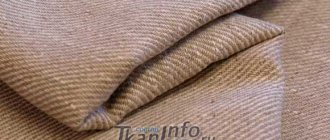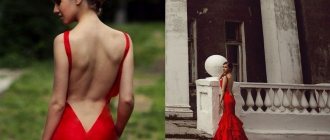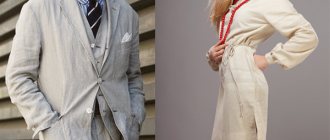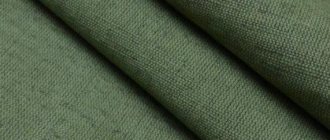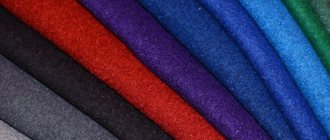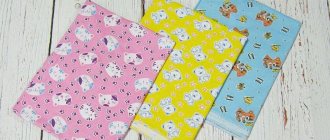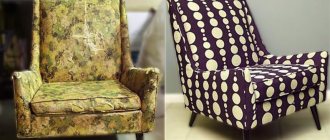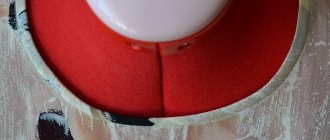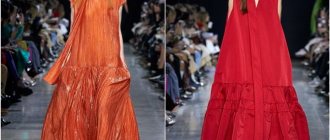What does a bride pay attention to first when choosing a wedding dress? Of course, on the style and fabric. Usually girls know in advance which material is preferable for them. Those who dream of a classic look will probably choose satin, silk, chiffon or lace. Original brides can turn their attention to fabrics such as jacquard, velvet or even denim.
Advertising - Continued below
We invite you to consider the most popular “wedding” and not so popular fabrics in more detail: and learn about their features, pros and cons.
Satin wedding dresses
Atlas. Photo: Crafts Fair, fabric store “Emerald Owl”
Satin wedding dress. Photo: sv-valens.ru
Satin is one of the most popular materials for wedding dresses. Literally from Arabic this word is translated as “smooth”. The shiny surface of satin wedding dresses has attracted brides throughout the 20th century. Satin is sometimes even called wedding dress fabric. This lightweight and pleasant-to-touch material is suitable for almost all classic wedding styles.
Decor of wedding dresses with mesh and beads
After conducting a little research into what wedding dresses are most often made from, we found out that mesh fabrics remain extremely popular among brides. Nets have become classics of wedding fashion, because the combination of transparent details with dense ones has not lost its relevance for several decades. Guipure, tulle, and so-called gauze are combined with a matte or smooth base, complemented with sewn elements and embroidery.
What is the name of the fabric of a wedding dress - transparent, decorated with beads? For this design, a mesh with beads is used, matched to the dense base of the outfit. Using this fabric for sewing a wedding dress is very beneficial in terms of creating a single ensemble of veil and dress. In our fabric store you can usually find matching materials for the base and decorative details, with or without finished trim.
Mesh with beads usually has quite high elasticity, so the presence of decorative elements does not deform the material. The texture of the fabric is most often distinctly cellular, but not rough and not prone to puffs and creases.
Mesh with beads is considered the best fabric for wedding dresses because it is convenient for craftswomen to work with, and dresses made from it do not require additional effort in decorating the dress. A well-thought-out style in itself is an elegant decoration of the bride’s image.
Advantages
- Spectacular and undoubtedly solemn appearance.
- Possibility of creating draperies, sewing veils.
- Simplicity of decoration - the fabric is initially decorated and does not require additional work.
Flaws
- Ironing only with steam irons.
- Cheap varieties may have beads with an unstable coating, but this may only be a problem for rental items.
Choose a mesh with beads for wedding dresses in the catalog ->
Tulle wedding dresses
Fatin
Wedding dress with a full tulle skirt. Photo: olga-welling.ru
Tulle is in second place in popularity. It is also used when sewing classic styles such as “Princess” or “Mermaid”. Tulle is a translucent and lightweight fabric that, when applied in several layers, maintains volume. Tulle wedding dresses can be different: with a multi-tiered or torn skirt, in a classic style or original with tulle flowers.
Advertising - Continued below
The finishing touch - wedding table decor
One of the main elements that are decorated at a wedding is tables. All guests pay attention to them and it is they who create the entire atmosphere of the banquet hall. Before you start decorating, you should first decide what color the entire wedding will be in. The color of the fabric must be in harmony with the general background, i.e. including the color of the walls in the establishment.
It is important to choose the fabric of the right texture - it should be dense, not slip on the table, and keep its shape. Over the past few seasons, shiny tablecloths, velvet fabrics, and elegant lace have been in fashion. Designers beautifully create multi-layered decors and combine colors.
Bride
Don’t forget that you need to match the tablecloth with fabric that matches the napkins, which should not blend into the table, but should match the tone.
Every wedding requires a selection of fabric. If you approach it, taking into account all the nuances described in the article, then it will not be difficult to do.
Chiffon wedding dresses
Chiffon. Photo: modelyersha.ru
Chiffon wedding dress. Photo: afrodita-sv.ru
Chiffon is a light and almost weightless fabric. Most often, scarves or summer sundresses are made from it. In wedding dresses, chiffon is most often used for decoration. For example, when creating a voluminous cloud for an airy skirt. Chiffon is indispensable if the girl chose a classic ball gown for her wedding. The advantage of this material is its low price. Although a few centuries ago everything was different: chiffon dresses were worn exclusively by royalty and they were very expensive. Today chiffon is available to everyone. At the same time, fluffy chiffon dresses still look great!
Atlas
Thanks to its rich appearance, durability and ease of processing, satin is one of the fabrics most often used for celebrations. It can be dense and lightweight, natural and artificial. Its advantages are:
• has a shiny, smooth surface that makes the fabric elegant;
• holds its shape perfectly due to its density;
• drapes easily, so satin can be used to create complex designs consisting of several layers;
• withstands decoration from beads, rhinestones, bugles, crystals, without stretching or sagging.
This rich material combines well with other fabrics. This is why fashion designers love it, combining it with various matte fabrics, lace, organza, embroidery and creating a harmonious wedding look.
A satin dress is indispensable if the wedding is scheduled for the cold season. In addition, it will be appropriate in luxurious interiors. Any style is suitable for this fabric.
The disadvantages of satin include the fact that it wrinkles easily. The bride should also remember that in the summer she will be very hot in a wedding dress made of thick fabric.
Lace wedding dresses
Lace. Photo: itsmyday.com.ua
Lace wedding dress. Photo: sv-valens.ru
Lace wedding dresses are back in trend this season. This luxurious, sexy and at the same time lightweight fabric is loved by fashionistas all over the world. The thing is that lace can look completely different - it all depends on the style. For example, a closed, fluffy dress that has a lace top and a satin skirt will make the bride’s image more modest and noble. A completely lace and tight-fitting wedding dress, on the contrary, turns a girl into a fatal and captivating beauty.
How much fabric is needed for a wedding dress
When purchasing fabric for a wedding dress, it is important to decide in advance on the style of the model and decide what texture the dress will have.
If the dress is planned to be of a simple style without excessive pomp, then you can take a cut of 1.5 * 2 meters.
To sew a fluffy dress, it takes at least 3 meters, and if you are also planning a harness, then you can add another 2 meters.
You may be interested in this Features of artificial suede in furniture and clothing
Curvy style
Important. The most correct approach when calculating the fabric for a dress is to turn to an experienced seamstress who can calculate everything efficiently and not make a mistake.
Guipure wedding dresses
Guipure
Guipure wedding dress. Photo: sv-valens.ru
Guipure is a material for graceful and sophisticated brides. It appeared in the 16th century in Italy, when its pattern was in the form of twigs and leaves. Now the patterns may be different, but floral motifs still prevail. Guipure is very often confused with lace; these materials are indeed very similar, the main difference is that synthetic threads are added to guipure. This makes the fabric more durable.
Denim wedding dresses
Denim fabric. Photo: Nazya.com
Denim dress. Photo: sdress.ru
A denim wedding dress is an original option for an extravagant and fashionable bride. Denim is a symbol of freedom and independence of thought. Today, a dress made of jeans can be found in the wedding collections of popular designers: most often it is used to sew a corset for a dress or to trim a skirt. If you are hesitant to wear such a dress, but you like this fabric, there is a compromise: separate details and elements of the wedding dress. This could be a denim shirt, vest, jacket or brooch.
Velvet wedding dresses
Velvet. Photo: mytextile.ru
Velvet dress. Photo: radelya.ru
Velvet has always been considered a royal material; it was used to sew clothes for courtiers and also decorate the palaces of kings. Today velvet is one of the most trendy materials. Gorgeous evening dresses are made from it, and it also fits into winter wedding style. Brides tend to choose velvet wedding dresses in unusual colors: red, green, cream and pale pink. In a white velvet dress in winter, a girl will look like a real Snow Queen.
Advertising - Continued below
Who is suitable for wedding dresses made of thick fabric?
Thick wedding dresses are suitable for brides who want to look expensive and aristocratic. Their volume suits fragile girls. Due to their ability to retain heat, dense materials are suitable for winter. They fit well into themed weddings of different stylistic trends. You can read how to choose a wedding style here.
Silk wedding dresses
Silk
Silk wedding dress. Photo: pronovias.com
Silk wedding dresses are a special love of fashion designers around the world. After all, there is, perhaps, no other such sparkling and elegant fabric. Now silk is used to sew dresses in a rustic style. Silk has only two drawbacks: it wrinkles a lot, and can also emphasize figure flaws. Therefore, the bride needs to be more careful when choosing: a silk wedding dress should fit you perfectly.
Satin wedding dress: what you need to know before buying
Since ancient times, satin has been a symbol of luxury and prosperity. It is not for nothing that previously only representatives of the aristocracy and brides from wealthy families walked down the aisle in satin dresses. Wedding tells you what details are important to pay attention to if you are considering models made from this fabric.
Satin wedding dresses have not gone out of fashion for many years. Such stars as Victoria Beckham, Angelina Jolie, Mariah Carey got married in them. And Hailey Bieber and Kim Kardashian chose this model as a second dress for their wedding party. Satin wedding dresses always look impressive, regardless of the style. Even if you choose a simple slip dress in the style of top model Toni Garrn, it will still attract attention and help create a unique wedding look.
Pros and cons of the atlas
It is enough to look at the latest collections of the brands Edem, Galia Lahav and Vera Wang to finally make a choice in favor of a satin wedding dress. Such flowing dresses perfectly fit the figure and make the image feminine. Also, a satin dress does not require additional decorations, as it looks expensive in itself. Here are a few more reasons to think about buying a satin wedding dress:
- The iridescent fabric will highlight the sophistication of the bride.
- Satin dresses look very sexy.
- If you choose the right style, this dress will suit almost any wedding style.
- Satin dresses are always pleasant to the touch.
- Satin wedding dresses with long sleeves are the best option for a formal wedding.
- In all photos and videos you will look like a real movie star.
A satin wedding dress does not have to be in the spirit of royalty: lush, shiny and with puffed sleeves. Try on a playful mini dress (as an option for a disco), a trendy oversized tuxedo or a minimalist dress with thin straps and once again make sure that the fabric complements any of the current wedding styles.
However, the atlas has its drawbacks. Famous designers do not advise wearing a satin dress to a wedding if you want to hide figure flaws or are afraid that it will visually increase volume in photographs. We share a list of other features that every bride should know about before purchasing a satin dress:
- If you choose the wrong color, shiny fabric will unfavorably highlight your skin tone. Therefore, it is important to try on a satin dress in both daylight and artificial light.
- Wedding dresses made from satin fabric may become wrinkled during the wedding day, which will be visible in photographs.
- Remember that this is a very delicate fabric that can easily form puffs.
- After contact with water, streaks will remain on the dress.
- The model you like can be made of thick satin, which does not “breathe” well and is not suitable for a wedding in the hot season.
- Please note that an outfit made of synthetic fabric will be electrified.
How to choose a style
Today, satin dresses are presented in many fashion houses, so choosing a model to suit every taste will be easy. But before trying on, you should clearly define the concept of the wedding. Perhaps you will immediately imagine a discreet and at the same time elegant dress or see yourself in a trendy transformable dress in the style of Vivienne Westwood. There are many options, but we advise you to start from the format of the celebration and the character of the bride.
Fluffy, floor-length dresses may be suitable for a bride who dreams of a majestic wedding in a palace or estate, while an outfit with lace trim is suitable for a romantic or classic ceremony. And brides inspired by loft and urban chic styles will definitely love the trendy tuxedos, slip dresses and bodycon styles with fashionable American armholes. If desired, this look can be complemented with stylish accessories: a hat, headband, wide belt and massive jewelry.
A satin dress can also be interestingly combined with a midi length, A-line silhouette and pockets. But the most popular among satin wedding dresses remains the “mermaid” style, emphasizing the waist and hips.
But satin dresses trimmed with rhinestones in the Greek style in 2021 were among the main anti-trends. According to designers, they look too cheap, and the pretentious design interrupts all the beauty of the noble fabric. So it’s better to abandon this option in favor of classic models or choose a style of wedding dress with lace appliqués as the main decorative element.
So that the fabric does not let you down
The atlas may be different. Modern technologies make it possible to process fabric so that it appears more matte and dense or, conversely, shiny and weightless. If you dream of a strict and at the same time sophisticated look, look for a wedding dress made of mikado fabric. This type of satin is stiffer than usual, so it holds its shape well and allows you to emphasize the architecture of the dress.
Text: Tatyana Veselova.
Photo: Ralina Gazizova.
Organza wedding dresses
Organza. Photo: poshvu.ru
Wedding dress with an organza skirt. Photo: svadbagarderob.ru
Organza is a translucent thin fabric that is woven from several types of fibers. Most often, fashion designers use organza when sewing skirts for wedding dresses. Organza wedding dresses are created for those brides who want to feel like a fairy-tale princess - they look extremely impressive! Very often, organza acts as an additional decoration for a dress - ruffles, flounces, frills. The advantages of organza are that it hardly wrinkles, retains its shape for a long time, is very durable, and at the same time light and pleasant to the touch. There is only one drawback - you need to iron it especially carefully.
Organza
When answering the question of what fabrics wedding dresses are made from, designers often name organza. This fabric, containing polyester, viscose and silk, is highly breathable, durable, lightweight and does not wrinkle.
The rigidity of the material makes it possible to make magnificent outfits from it. In the sun, this fabric shimmers in different colors, surrounding the image of the bride with some mystery. Organza makes the most voluminous skirts, flounces and voluminous sleeves.
An organza dress is suitable for both summer and winter weddings. In this light material, the bride will not feel the influence of the summer heat. But if you make a multi-layer drapery from organza, then this outfit will be cozy even in winter.
Linen wedding dresses
Linen. Photo: izolna.ru
White linen dress. Photo: dd-shop.ru
Naturalness and naturalness are held in high esteem today! Over the past few years, fashion has increasingly been looking towards simple materials. One of the most popular is linen. Linen wedding dresses are chosen by those who are close to rustic, vintage or Provence style. Suitable styles for this material are sundresses, A-line dresses and loose-fitting dresses.
Advertising - Continued below
The biggest advantage of linen dresses is their hypoallergenicity. In this outfit, any bride will feel comfortable and cozy throughout the entire celebration. Well, and, of course, we must not forget about the touching romantic charm that surrounds any linen wedding dress.
Choosing fabric depending on your body type
The style of a well-chosen dress directly depends on the type of female figure. Based on this, fabrics for wedding dresses should be selected according to the figure:
- Hourglass. An almost ideal figure that will suit any style of dress. Accordingly, you can safely take the type of fabric you like. Greek dresses look beautiful and elegant, and godet products will make your look unique and inimitable.
"Hourglass"
- Pear. It is best to choose light fabrics for such a figure. A dress in the Greek style or A-line will fit well. They will advantageously emphasize the waist, but at the same time hide the hips.
- Apple. For such a figure, it is best to avoid tight fabrics; you should look towards flowing ones. These dresses can add femininity and smooth lines. If you really want a fluffy dress, then you should pay attention to the presence of a corset. He is the one who will be able to visually create a waist.
- Rectangle. This figure is best suited for short wedding dresses because... girls with such a figure usually have long slender legs. The dress can be either tight or airy, so there are no special requirements for fabrics.
"Triangle"
- Triangle. Here, without any confusion, the most successful choice would be to choose an A-line dress with tight fabrics on top to hide a wide chest, and an airy bottom to give volume to the hips.
In general, not only wedding dresses, but any clothing should be selected according to these criteria.
Satin wedding dresses
Satin. Photo: textile-home.ru
Satin wedding dress
Satin is a dense material with a shiny and smooth surface. Sometimes satin is confused with silk or satin: this happens because the basis of the fabric can be different fibers, including silk. But satin, unlike silk, is very durable and almost does not wrinkle.
Other important advantages include that it does not electrify and is pleasant to the touch. Brides who choose satin wedding dresses should remember that in this material any girl will look quite strict and restrained. Therefore, satin is perfect for brides 30+ and those who prefer laconic elegance.
Advertising - Continued below
Types of fabrics
Over the past few seasons, wedding fabrics with relief patterns and ornaments have been very popular. However, there are classic fabrics that are timeless:
- Atlas. This is the simplest possible (due to its smoothness), but at the same time rich, noble matter. It is often used as a basis for a dress, because... it withstands sewing beads and stones well without deforming. Satin looks good in addition to other fabrics. Dresses are often made from it for the cold season; it looks great in any style. The disadvantage of the fabric is its density; satin products will be heavy to wear and prone to wrinkles.
Atlas
- Satin. It is very similar in appearance to satin, but practically does not wrinkle. It comes in both matte and shiny. Satin dresses with embroidery look great.
- Silk. One of the most expensive materials. The best models of silk dresses are form-fitting (mermaid or A-line). Such products emphasize femininity, the main thing is to choose the right style. Silk is difficult to work with, so it can only be trusted to professionals. Due to the natural nature of the material, it wrinkles easily.
Silk
- Organza. This is a very thin transparent airy matter. It shimmers beautifully in the sun, so it is often complemented with dresses. There is matte organza on the market. Noble expensive material that gives the dress pomp and lightness.
- Chiffon. Translucent fabric used to create a romantic, airy look. It makes beautiful flowing dresses. Often used in drapery, for finishing bodice, veil, etc. These dresses are very comfortable.
Chiffon
- Fatin. Mesh material from which skirts on wedding dresses and veils are sewn. The fabric is extremely easy to work with and does not require edge processing. The famous Vera Wang actively uses this look in her collections.
- Lace. The most delicate material, especially if it is made not by machine, but by hand. Almost no dress is complete without it. Dresses are complemented with lace, sleeves are made from them, or even the product is completely sewn. Lace comes in completely different colors.
- Crepe. Wrinkle-resistant fabric, often combined with lace. It looks smooth and graceful. There is a large selection of crepe on the market, it can be natural or artificial, and also of different densities.
You might be interested in this Description of all varieties of Slavic fabrics
Crepe
- Brocade. A material that uniquely emphasizes luxury. Available in gold and silver shades, it contains an admixture of silk threads. Winter dresses are often made from brocade.
- Taffeta. It looks like satin, but does not wrinkle and is an order of magnitude lighter. Absolutely different outfits are sewn from it; taffeta holds its shape well, so it is especially relevant for models with ruffles. Taffeta can be bought inexpensively. Combine with tidal elements, tulle or silk.
- Crinoline. A tough but pleasant-to-touch material, which is mainly used for petticoats for full dresses. Due to this, they keep their shape well and the splendor does not fall off.
Crinoline
Taffeta wedding dresses
Taffeta
Taffeta wedding dress. Photo: rstelle.ru
Taffeta came to us from Persia; this word is translated as “woven.” It is made from twisted threads: the fabric is dense, and at the same time light and thin. A classic A-line taffeta wedding dress is the perfect outfit that will suit any bride, regardless of body type.
What fabrics are wedding dresses made from - review
Before you start choosing an option for an outfit, study all the features of suitable fabrics.
- Atlas. This material is considered a classic; it is light and flowing. The shine of satin attracts girls, and this is what explains its popularity. Often, several types of material are combined in a wedding dress. Matte fabrics go well with satin. Various decorative elements, such as beads or glass beads, look good on a shiny surface. The only downside is that the fabric itself wrinkles easily.
- Organza. This material is no less popular than satin. It is made from viscose, silk and polyester, the two fibers are twisted together. As a rule, organza is used to decorate an outfit; it holds its shape perfectly due to its slight rigidity, while being moderately transparent.
- Chiffon. Chiffon is often chosen to decorate dresses. The material is incredibly light, but it is not suitable as a base because it does not hold its shape. Chiffon can only create airiness.
- Lace. These outfits look truly chic and elegant. This fabric is the pure embodiment of femininity, romanticism and tenderness. Beautiful ornament, curving lines, moderate transparency - this is what adorns the bride.
- Crepe. It is universal in its own way, since it can be both light and heavy. For tailoring, as a rule, smooth crepe is used. The material goes well with any decorative elements.
- Brocade. The material is quite dense and weighty, so it is unlikely to be suitable for the warm season. But for a winter wedding, brocade will be the ideal material. At all times, it was expensive, and only noble people could afford it. The material included fibers from gold and silver threads. Now, of course, the availability of this material is not so problematic, because the manufacturing technique has changed, but this has not in the least affected the external characteristics of the fabric. Brocade, as before, attracts glances and enchants young brides.
Jacquard wedding dresses
Jacquard. Photo: modelyersha.ru
Jacquard wedding dress. Photo: ldweddingculture.com
Jacquard is a smooth, lint-free fabric with a special pattern: it is created by intertwining several threads. These threads can be made from different materials: natural, synthetic or mixed. Wedding dresses made of silk jacquard look especially impressive.
The advantages of this fabric: strength, wear resistance and durability. Of the minuses: jacquard wedding dresses have a high price. By the way, it is believed that jacquard is the ideal fabric for a short wedding dress.
Wedding satin
Smooth, shiny. It looks expensive and noble.
- Tight-fitting silhouettes, full skirts, bodices.
Brocade
Shiny fabric. Relief pattern.
- A-line silhouettes, dresses of complex styles
Velvet
Fabric of kings. Soft pile. Made from silk and cotton. Add elastane.
- Capes, jackets, dresses with trains.
For any season
Lace
Delicate, refined. Ideal for a big holiday or a modest celebration.
Chantilly - warm days, guipure, cordova - cool weather.
- Dresses, trim, decorations
Taffeta
Smooth, shiny. Thin - for summer, dense - autumn, winter.
- All types of dresses, draperies, full skirts
Net
Lightweight, transparent.
- Veils, petticoats, ballerina style, veils, jewelry, trim.
